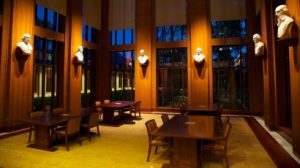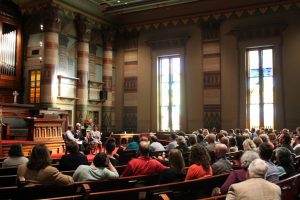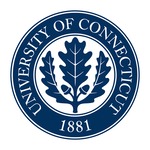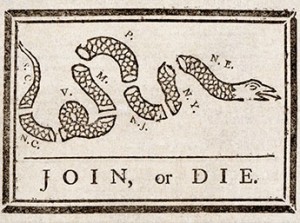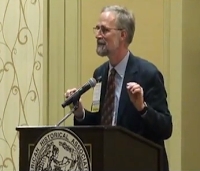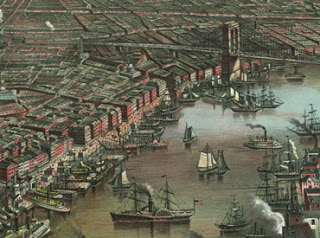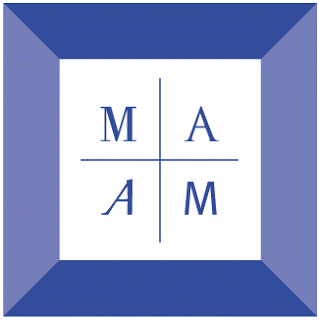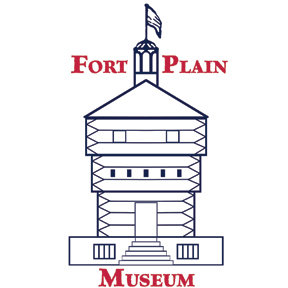
Local history organizations in New York State create history conferences. This comparatively unexplored facet to the history community provides examples, lessons, and insight into what is being done and potentially what could be done.
In the past few weeks, I have participated in the third-annual American Revolution Mohawk Valley Conference organized by the Fort Plain Museum and in the Erie Canal 200 Bicentennial Conference organized by the Oneida County History Council and the Canal Society of New York. I should note that during this period I was the recipient of frequent notices about the Peterboro Civil War Weekend the same time as the American Revolution conference. I further note that I have occasionally attended French and Indian War and American Revolution Conferences at Fort Ticonderoga, Underground Railroad Public History Conferences organized by the Underground Railroad History Project of The Capital Region, and baseball conferences in Cooperstown. I exclude from this discussion such annual organization conferences as by APHNYS, MANY, and the NYSHA back when there was a state history conference. I also am referring to multiday events that potentially require lodging by the participants.
As we all know, New York is rich in local, state, American and even world history. Becoming aware of that history and then immersing oneself in it sometimes requires more than a one-hour talk or tour. These history conferences provide a welcome opportunity for diehard aficionados, the educated, the biologically-connected, and local boosters to join together in an intellectual and physical shared experience…in some cases year after year.
Let me review some of the non-content lessons learned from these conferences. By that I mean I am not going to dispense content knowledge about the American Revolution or the Erie Canal, but to share observations about the conference experience.
Lesson #1 – It can be done . Kudos are deserved for the volunteer efforts by the local organizations who undertake the daunting task of organizing a conference. As someone who has organized both day-conferences and week-long Teacherhostels/Historyhostels, I know from personal experience that everything always takes longer than expected or desired and there always is more involved than originally anticipated. I strongly recommend that sessions be held at APHNYS and MANY about the logistical and organizational challenges in putting together such events. While it may not be possible or advisable to put together to rigid a procedural manual, there are lessons to be learned and benefits to be gained by sharing what is involved. In the meantime I encourage all such conference organizers to submit a post to New York History Blog on what is involved in organizing a conference.
Lesson #2 – Conferences generate revenue. The Erie Canal conference included 106 registrations including 72 who paid for a conference dinner at a restaurant, 82 who participated in a bus tour, and 86 who paid for a canal cruise. I don’t have the comparable numbers for the American Revolution conference but registration was in the range of 200 people, there were over 100 people at the conference dinner at a catered meal at an historic site, there were two 55-seat buses on the tour I took.
As an example of the revenue generated, consider my dinner-table companions at the American Revolution conference. Two people from North Carolina and Kansas had flown to New York, rented a car, and stayed in a motel. Two had driven from out-of-state and one from downstate (me) and stayed in a motel (and I know there was travel expense for at least one other – I don’t take notes at the dinner table so some of the details have been forgotten). The net result is that our one table generated more travel revenue than all the local Path through History events since the project was launched on August 28, 2012, have produced.
A few years ago, I think it was in the food court at Empire State Plaza in Albany where I saw Gavin Landry and Ross Levi of I LoveNY, I mentioned the potential of promoting history conferences as way of bringing people to (upstate) New York and generating revenue. As I recall, Ross responded favorably to the suggestion as something that should be done. It is something that should be done. As part of the REDC funding process there should be a bucket for funding history conferences.
Lesson #3 – Conferences create actual paths through history even when they aren’t on a Path through History weekend. At the Erie Canal conference there was a one day bus trip. Admittedly that bus tour was best for real canal buffs but let’s face facts, for almost anything you think of there are bound to be fans. Our local archaeology society in Westchester had a lecture recently on the discovery of the skeleton of King Richard III at a carpark in England. We had people from New Jersey and Philadelphia drive to attend a 45-minute lecture by the excavator. Who knew there was a King Richard III fan club? Thank you William Shakespeare. The point is not everybody is interested in something but there is a segment of the population interested in practically any aspect of New York State history if organized and promoted right. Whose job is it to do that?
As it turns out, one of the presenters at the Erie Canal conference was Dana Krueger, who is an organizer and member of the MANY board. Her presentation showcases what can be done and what isn’t being done. Interest in canals is a worldwide phenomenon. Naturally there is a conference for canal people. This year the World Canal conference will be in Syracuse due to the Erie Canal bicentennial. In her presentation Dana mentioned the various other canal activities besides the conference itself:
- There is a special one-day early-bird tour on the shipwrecks of Lake Champlain with lodging and travel arrangements from Albany.
- There is a two-day pre-conference tour on the Champlain and Eastern Erie Canals following immediately upon the special one day early-bird tour with travel and lodging arrangements from Albany.
- There is the third annual two-day cycling tour of the towpath through the Old Erie Canal State Historic Park which involves lodging and apparently is held independent of the World Canal conference.
- There is a three-day post conference Erie Canal tour from Syracuse to Buffalo.
The World Canal Conference website also mentions the possibility of additional “itineraries” through the Erie Canalway National Heritage Corridor. That website contains nine “itineraries.”
Don’t these tours and itineraries seem a lot like paths? How come none of these events are even listed on the Path through History website? Is the promotion for these tours limited to people who will attend the conference? Isn’t it possible that people would be interested in such early-bird, pre-conference, and post-conference tours in years when there is no canal conference or by people who are not going to attend the conference in Syracuse this year? Are these one-time tours or the beginning of a sustained repeatable development and promotion of paths through history based on one of the themes of the Path through History project? As one who has attended the Tourism Advisory Council meetings, I can say without hesitation, the World Canal Conference is a separate agenda item treated as a onetime event with no ongoing considerations for upstate tourist travel.
A similar situation occurred with the American Revolution conference. Two tours were offered. One repeated the one I had taken the first year…and was sold out by the time I registered for the conference this year. It focused on sites between exits 27 and 29 in the New York State Thruway depending on whether one was coming from the east or the west. The Exit 27 to 29 history organizations in Montgomery and Fulton counties have created a website call Mohawk Country and produced two brochures. Combined they feature about 20 sites. Individually, they tend not to be destination sites on their own. But these organizations take the collaboration and cooperation mantra seriously. Collectively Montgomery and Fulton counties have created the basis for a Mohawk Valley Path through History. Now what they need is tour operators. Recently Norm Bollen of the Fort Plain Museum addressed the Montgomery County legislators on the value of cultural heritage tourism. For these sites to put together bus tours outside the annual conference would be great achievement. Montgomery and Fulton counties should request the creation of Pathfinder as part of the REDC funding for this year. A little help from the state would be nice.
Finally I would like to share the experience of the annual conference of the Society for Industrial Archaeology held in Albany in 2015. Although it was two years ago, I have been saving the information for the right post and now is the time. Look at the trips this conference sponsored keeping in mind the specialized nature of industrial archaeology.
First there were the all-day trips with lunch and transportation provided
- Schenectady and vicinity
- Power and Transportation including the Amtrak and New York State Canals repair shops, the Port of Albany, Erie Canal at Waterford, and the Mechanicville Hydroelectric Plant, built 1897, oldest continuously operating plant in the nation with original equipment in service.
- Port of Coeymans where sections of the new Tappan Zee Bridge were being assembled; Scarano Boat Building, Port of Albany, builder of passenger ferries, cruise boats, and historic replica vessels; SUNY College of Nanoscale Engineering & Science, Albany, R&D facility for the microchip industry with complete prototyping lines.
- Hudson-Mohawk Industries in Cohoes, Troy, and Waterford.
- Bridges, both the manufacturing of them and those that have been built.
Participants had the option of choosing only one tour since all five were offered on the same day. One can see that combined, they would create a one-week program based in Albany. Quite obviously the focus of the tours was for specialists but how difficult would it be to create history tours involving Albany, Cohoes, Schenectady, Troy, and Waterford. Actually the problem would be limiting the tour to just five days! I speak from experience having created Capital Region Teacherhostels/Historyhostels and having scouted sites that couldn’t be included even in a week. Somehow the conference organizers were able to put together five one-day tours.
In addition to these tours which were part of the conference price, one also could take
- day bus trip to Sharon Springs
- four 1.5 to 2.5 hour tours in Albany during the course of a day
- day bus tour for Landmarks of the Hudson-Mohawk Region through historic industrial districts of North Albany, Watervliet, Cohoes, Waterford & Troy. One bus returned via Albany Airport for those who need to catch early afternoon flights.
How’s that for planning.
I have championed the creation of Pathfinders. These are people who would have the job of doing what these conference organizers have done but with the intention of creating repeatable sustainable tours. It is truly tragic with all tens of millions of dollars expended on touting New York, so little is devoted to building the infrastructure, the actual creation of tours for people to take. All tourists are just supposed to wing it by surfing the Path through History website to create one-time tours specifically for themselves. Makes you wonder how many people actually use the site to create such self-guided tours before traveling to New York.





